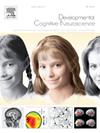逆境与神经网络组织的发育时间:关于难民流离失所影响的 fNIRS 研究
IF 4.9
2区 医学
Q1 NEUROSCIENCES
引用次数: 0
摘要
本研究调查了流离失所对加拿大重新安置的叙利亚难民儿童的神经发育影响,重点关注流离失所期间经历逆境的时间和持续时间如何影响神经网络组织。利用网络神经科学框架内的图论方法,我们研究了迁移的发展时机(迁移年龄、迁移持续时间)与功能整合、隔离和小世界的关系。叙利亚难民儿童(n = 61,MAge=14 Range = 8-18),使用功能性近红外光谱(fNIRS)神经成像完成静息状态扫描。分析数据以评估神经网络特性与逆境发育时间之间的联系。结果表明,早期经历的长期流离失所与神经网络组织显著相关,影响了大脑功能整合和分离之间的平衡,与老年经历流离失所相比,小世界的总体减少量化了这一点。这项研究利用难民儿童的经历来推进我们对逆境时机如何影响发展的理解,为早期逆境对神经发育的广泛影响提供了有价值的见解。本文章由计算机程序翻译,如有差异,请以英文原文为准。
Developmental timing of adversity and neural network organization: An fNIRS study of the impact of refugee displacement
This study investigated the neurodevelopmental impacts of displacement on resettled Syrian refugee children in Canada, focusing on how the timing and duration of adversity experienced during displacement influence neural network organization. Using graph theoretical approaches within a network neuroscience framework, we examined how the developmental timing of displacement (age of displacement, duration of displacement) related to functional integration, segregation, and small-worldness. Syrian refugee children (n = 61, MAge=14 Range = 8–18), completed a resting state scan using functional Near Infrared Spectroscopy (fNIRS) neuroimaging. Data were analyzed to assess the link between neural network properties and developmental timing of adversity. Results indicate that prolonged displacement experienced earlier in life was significantly linked with neural network organization, impacting the balance between the brain's functional integration and segregation as quantified by the overall reduced small worldness in comparison to experiencing displacement at an older age. This study leverages the experiences of refugee children to advance our understanding of how the timing of adversity affects development, providing valuable insights into the broader impacts of early adversity on neurodevelopment.
求助全文
通过发布文献求助,成功后即可免费获取论文全文。
去求助
来源期刊

Developmental Cognitive Neuroscience
NEUROSCIENCES-
CiteScore
7.60
自引率
10.60%
发文量
124
审稿时长
6-12 weeks
期刊介绍:
The journal publishes theoretical and research papers on cognitive brain development, from infancy through childhood and adolescence and into adulthood. It covers neurocognitive development and neurocognitive processing in both typical and atypical development, including social and affective aspects. Appropriate methodologies for the journal include, but are not limited to, functional neuroimaging (fMRI and MEG), electrophysiology (EEG and ERP), NIRS and transcranial magnetic stimulation, as well as other basic neuroscience approaches using cellular and animal models that directly address cognitive brain development, patient studies, case studies, post-mortem studies and pharmacological studies.
 求助内容:
求助内容: 应助结果提醒方式:
应助结果提醒方式:


